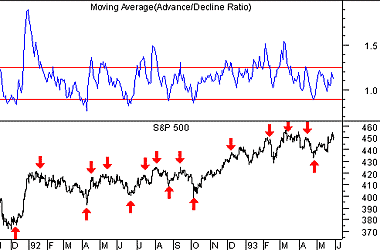
Technical Analysis from A to Z
by Steven B. Achelis
ADVANCE/DECLINE RATIO
Overview
The Advance/Decline Ratio ("A/D Ratio") shows the ratio of advancing issues to declining issues. It is calculated by dividing the number of advancing issues by the number of declining issues.
Interpretation
The A/D Ratio is similar to the Advancing-Declining Issues in that it displays market breadth. But, where the Advancing-Declining Issues subtracts the advancing/declining values, the A/D Ratio divides the values. The advantage of the Ratio is that it remains constant regardless of the number of issues that are traded on the New York Stock Exchange (which has steadily increased).
A moving average of the A/D Ratio is often used as an overbought/oversold indicator. The higher the value, the more "excessive" the rally and the more likely a correction. Likewise, low readings imply an oversold market and suggest a technical rally.
Keep in mind, however, that markets that appear to be extremely overbought or oversold may stay that way for some time. When investing using overbought and oversold indicators, it is wise to wait for the prices to confirm your belief that a change is due before placing your trades.
Day-to-day fluctuations of the Advance/Decline Ratio are often eliminated by smoothing the ratio with a moving average.
Example
The following chart shows the S&P 500 and a 15-day moving average of the A/D Ratio.

You can see that prices usually declined after entering the overbought level above 1.25 ("sell" arrows) and that they usually rallied after entering the oversold level below 0.90 ("buy" arrows).
Calculation
The A/D Ratio is calculated by dividing the number of stocks that advanced in price for the day by the number of stocks that declined.
![]()
Table 3 shows the calculation of the A/D Ratio.
| Table 3 | |||
| Date | Advancing | Declining | A/D Ratio |
|---|---|---|---|
| 02/15/94 | 1198 | 882 | 1.3583 |
| 02/16/94 | 1183 | 965 | 1.2259 |
| 02/17/94 | 882 | 1251 | 0.7050 |
| 02/18/94 | 706 | 1411 | 0.5004 |
| 02/22/94 | 1139 | 1003 | 1.1356 |
Contents
- Preface
- Acknowledgments
- Terminology
- To Learn More
- Bibliography
- About the Author
- Technical Analysis
- Price Fields
- Charts
- Support & Resistance
- Trends
- Moving Averages
- Indicators
- Market Indicators
- Line Studies
- Periodicity
- The Time Element
- Conclusion
- Absolute Breadth Index
- Accumulation/Distribution
- Accumulation Swing Index
- Advance/Decline Line
- Advance/Decline Ratio
- Advancing-Declining Issues
- Advancing, Declining, Unchanged Volume
- Andrews' Pitchfork
- Arms Index
- Average True Range
- Bollinger Bands
- Breadth Thrust
- Bull/Bear Ratio
- Candlesticks - Japanese
- CANSLIM
- Chaikin Oscillator
- Commodity Channel Index
- Commodity Selection Index
- Correlation Analysis
- Cumulative Volume Index
- Cycles
- Demand Index
- Detrended Price Oscillator
- Directional Movement
- Dow Theory
- Ease of Movement
- Efficient Market Theory
- Elliott Wave Theory
- Envelopes (Trading Bands)
- Equivolume/Candlevolume
- Fibonacci Studies
- Four Percent Model
- Fourier Transform
- Fundamental Analysis
- Gann Angles
- Herrick Payoff Index
- Interest Rates
- Kagi
- Large Block Ratio
- Linear Regression Lines
- MACD
- Mass Index
- McClellan Oscillator
- McClellan Summation Index
- Median Price
- Member Short Ratio
- Momentum
- Money Flow Index
- Moving Averages
- Negative Volume Index
- New Highs-Lows Cumulative
- New Highs-New Lows
- New Highs/Lows Ratio
- Odd Lot Balance Index
- Odd Lot Purchases/Sales
- Odd Lot Short Ratio
- On Balance Volume
- Open Interest
- Open-10 TRIN
- Option Analysis
- Overbought/Oversold
- Parabolic SAR
- Patterns
- Percent Retracement
- Performance
- Point & Figure
- Positive Volume Index
- Price and Volume Trend
- Price Oscillator
- Price Rate-of-Change
- Public Short Ratio
- Puts/Calls Ratio
- Quadrant Lines
- Relative Strength, Comparative
- Relative Strength Index
- Renko
- Speed Resistance Lines
- Spreads
- Standard Deviation
- STIX
- Stochastic Oscillator
- Swing Index
- Three Line Break
- Time Series Forcast
- Tirone Levels
- Total Short Ratio
- Trade Volume Index
- Trendlines
- TRIX
- Typical Price
- Ultimate Oscillator
- Upside/Downside Ratio
- Upside/Downside Volume
- Vertical Horizonal Filter
- Volatility, Chaikin's
- Volume
- Volume Oscillator
- Volume Rate-of-Change
- Weighted Close
- Williams' Accumulation/Distribution
- Williams' %R
- Zig Zag